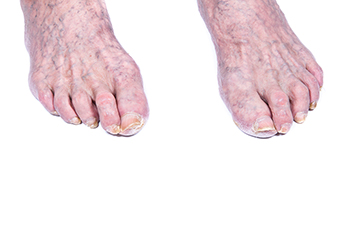Connect With Us
Blog
Items filtered by date: April 2024
Common Foot Problems Among Seniors

With age comes a myriad of changes to the feet that can affect both their health and functionality. Seniors need to recognize and address common foot problems to maintain mobility and overall well-being. Wearing ill-fitting shoes is a frequent cause of foot problems among older adults. Footwear that lacks proper support and space, can lead to issues like bunions, corns, calluses, and hammertoes. Additionally, the natural aging process brings physical changes, such as decreased padding, flattened arches, stiffened joints, and dry skin, all of which contribute to heightened vulnerability to foot ailments. Underlying health conditions like diabetes, arthritis, neuropathy, poor circulation, and obesity can contribute to foot pain. These ailments increase the risk of complications such as diabetic foot problems and arthritis-related foot deformities. Heel pain, arch problems, tarsal tunnel syndrome, and skin growth are additional problems among seniors. Regular check-ups with a podiatrist not only address existing concerns but also offer proactive measures to maintain healthy feet and sustain an active lifestyle. For personalized care and treatment plans to alleviate foot pain, it is suggested that you schedule an appointment with a podiatrist.
Proper foot care is something many older adults forget to consider. If you have any concerns about your feet and ankles, contact Steven Ginex, DPM from Palm Desert Podiatry. Our doctor can provide the care you need to keep you pain-free and on your feet.
The Elderly and Their Feet
As we age we start to notice many changes in our body, but the elder population may not notice them right away. Medical conditions may prevent the elderly to take notice of their foot health right away. Poor vision is a lead contributor to not taking action for the elderly.
Common Conditions
- Neuropathy – can reduce feeling in the feet and can hide many life-threatening medical conditions.
- Reduced flexibility – prevents the ability of proper toenail trimming, and foot cleaning. If left untreated, it may lead to further medical issues.
- Foot sores – amongst the older population can be serious before they are discovered. Some of the problematic conditions they may face are:
- Gouging toenails affecting nearby toe
- Shoes that don’t fit properly
- Pressure sores
- Loss of circulation in legs & feet
- Edema & swelling of feet and ankles
Susceptible Infections
Diabetes and poor circulation can cause general loss of sensitivity over the years, turning a simple cut into a serious issue.
If you have any questions please feel free to contact our office located in Palm Desert, CA . We offer the newest diagnostic and treatment technologies for all your foot and ankle needs.
